CCA's Financial Statement and Stakeholder Relationship
VerifiedAdded on 2019/11/14
|17
|4212
|285
Report
AI Summary
Beverage products consumption policies produced by health and environmental advocates focus on litter and obesity matters, orientated at government seeking novel revenue sources. CCA engages with stakeholders to raise awareness for more regulations. The institution's relationship with partners like TCCC is crucial for growth. Business continuity risks from utility disruptions, natural disasters, and regulatory changes are mitigated through a framework and insurance covers.
Contribute Materials
Your contribution can guide someone’s learning journey. Share your
documents today.
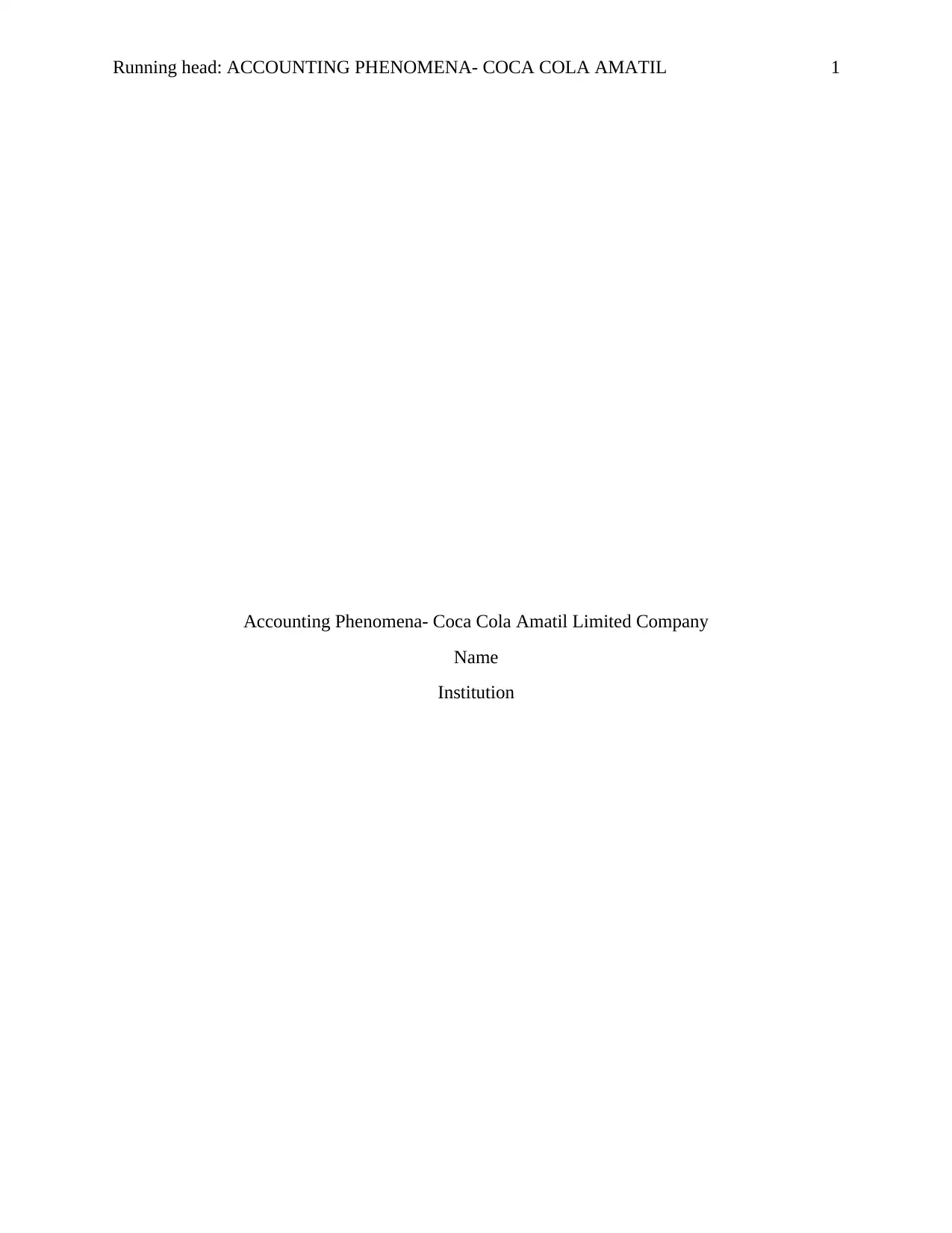
Running head: ACCOUNTING PHENOMENA- COCA COLA AMATIL 1
Accounting Phenomena- Coca Cola Amatil Limited Company
Name
Institution
Accounting Phenomena- Coca Cola Amatil Limited Company
Name
Institution
Secure Best Marks with AI Grader
Need help grading? Try our AI Grader for instant feedback on your assignments.
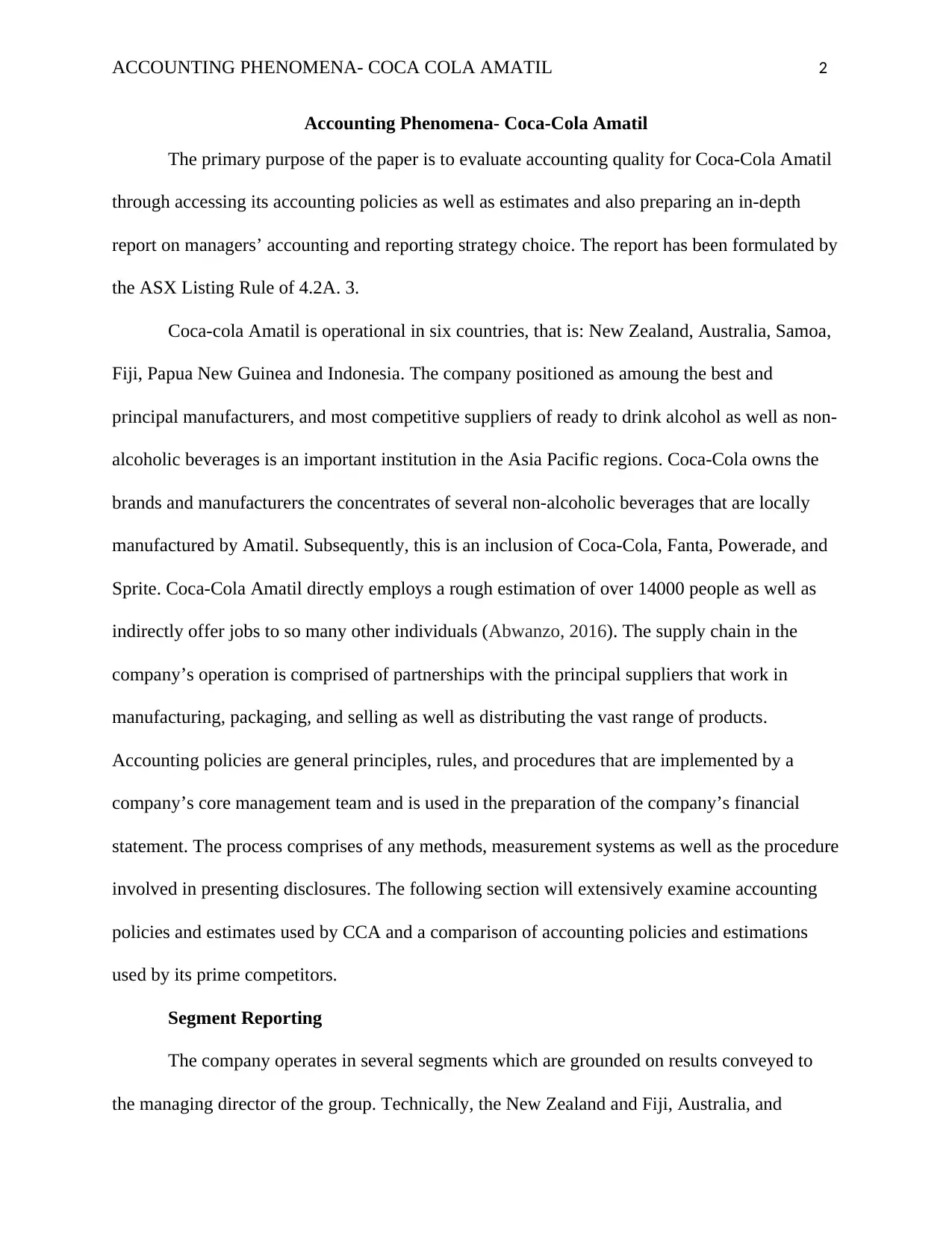
ACCOUNTING PHENOMENA- COCA COLA AMATIL 2
Accounting Phenomena- Coca-Cola Amatil
The primary purpose of the paper is to evaluate accounting quality for Coca-Cola Amatil
through accessing its accounting policies as well as estimates and also preparing an in-depth
report on managers’ accounting and reporting strategy choice. The report has been formulated by
the ASX Listing Rule of 4.2A. 3.
Coca-cola Amatil is operational in six countries, that is: New Zealand, Australia, Samoa,
Fiji, Papua New Guinea and Indonesia. The company positioned as amoung the best and
principal manufacturers, and most competitive suppliers of ready to drink alcohol as well as non-
alcoholic beverages is an important institution in the Asia Pacific regions. Coca-Cola owns the
brands and manufacturers the concentrates of several non-alcoholic beverages that are locally
manufactured by Amatil. Subsequently, this is an inclusion of Coca-Cola, Fanta, Powerade, and
Sprite. Coca-Cola Amatil directly employs a rough estimation of over 14000 people as well as
indirectly offer jobs to so many other individuals (Abwanzo, 2016). The supply chain in the
company’s operation is comprised of partnerships with the principal suppliers that work in
manufacturing, packaging, and selling as well as distributing the vast range of products.
Accounting policies are general principles, rules, and procedures that are implemented by a
company’s core management team and is used in the preparation of the company’s financial
statement. The process comprises of any methods, measurement systems as well as the procedure
involved in presenting disclosures. The following section will extensively examine accounting
policies and estimates used by CCA and a comparison of accounting policies and estimations
used by its prime competitors.
Segment Reporting
The company operates in several segments which are grounded on results conveyed to
the managing director of the group. Technically, the New Zealand and Fiji, Australia, and
Accounting Phenomena- Coca-Cola Amatil
The primary purpose of the paper is to evaluate accounting quality for Coca-Cola Amatil
through accessing its accounting policies as well as estimates and also preparing an in-depth
report on managers’ accounting and reporting strategy choice. The report has been formulated by
the ASX Listing Rule of 4.2A. 3.
Coca-cola Amatil is operational in six countries, that is: New Zealand, Australia, Samoa,
Fiji, Papua New Guinea and Indonesia. The company positioned as amoung the best and
principal manufacturers, and most competitive suppliers of ready to drink alcohol as well as non-
alcoholic beverages is an important institution in the Asia Pacific regions. Coca-Cola owns the
brands and manufacturers the concentrates of several non-alcoholic beverages that are locally
manufactured by Amatil. Subsequently, this is an inclusion of Coca-Cola, Fanta, Powerade, and
Sprite. Coca-Cola Amatil directly employs a rough estimation of over 14000 people as well as
indirectly offer jobs to so many other individuals (Abwanzo, 2016). The supply chain in the
company’s operation is comprised of partnerships with the principal suppliers that work in
manufacturing, packaging, and selling as well as distributing the vast range of products.
Accounting policies are general principles, rules, and procedures that are implemented by a
company’s core management team and is used in the preparation of the company’s financial
statement. The process comprises of any methods, measurement systems as well as the procedure
involved in presenting disclosures. The following section will extensively examine accounting
policies and estimates used by CCA and a comparison of accounting policies and estimations
used by its prime competitors.
Segment Reporting
The company operates in several segments which are grounded on results conveyed to
the managing director of the group. Technically, the New Zealand and Fiji, Australia, and
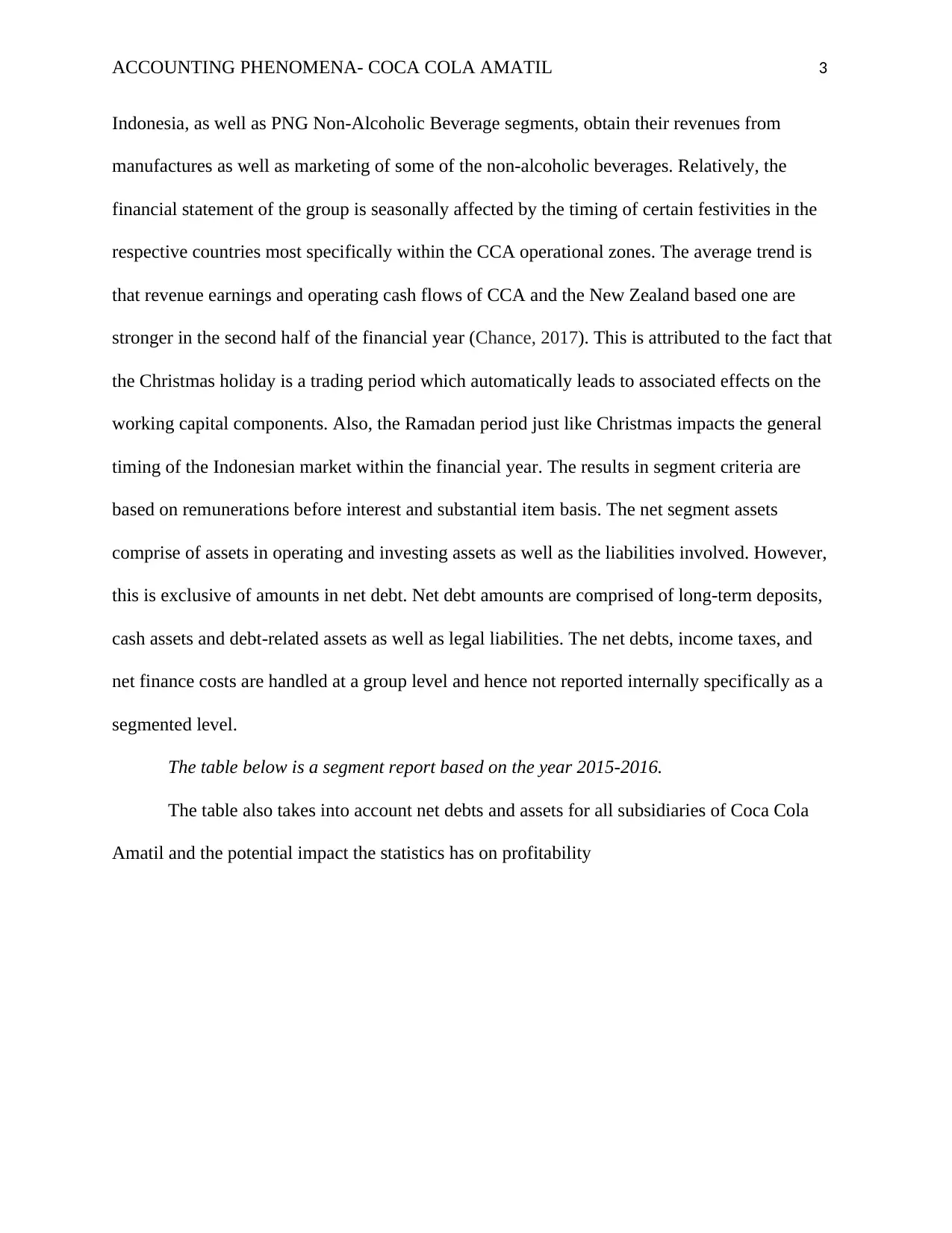
ACCOUNTING PHENOMENA- COCA COLA AMATIL 3
Indonesia, as well as PNG Non-Alcoholic Beverage segments, obtain their revenues from
manufactures as well as marketing of some of the non-alcoholic beverages. Relatively, the
financial statement of the group is seasonally affected by the timing of certain festivities in the
respective countries most specifically within the CCA operational zones. The average trend is
that revenue earnings and operating cash flows of CCA and the New Zealand based one are
stronger in the second half of the financial year (Chance, 2017). This is attributed to the fact that
the Christmas holiday is a trading period which automatically leads to associated effects on the
working capital components. Also, the Ramadan period just like Christmas impacts the general
timing of the Indonesian market within the financial year. The results in segment criteria are
based on remunerations before interest and substantial item basis. The net segment assets
comprise of assets in operating and investing assets as well as the liabilities involved. However,
this is exclusive of amounts in net debt. Net debt amounts are comprised of long-term deposits,
cash assets and debt-related assets as well as legal liabilities. The net debts, income taxes, and
net finance costs are handled at a group level and hence not reported internally specifically as a
segmented level.
The table below is a segment report based on the year 2015-2016.
The table also takes into account net debts and assets for all subsidiaries of Coca Cola
Amatil and the potential impact the statistics has on profitability
Indonesia, as well as PNG Non-Alcoholic Beverage segments, obtain their revenues from
manufactures as well as marketing of some of the non-alcoholic beverages. Relatively, the
financial statement of the group is seasonally affected by the timing of certain festivities in the
respective countries most specifically within the CCA operational zones. The average trend is
that revenue earnings and operating cash flows of CCA and the New Zealand based one are
stronger in the second half of the financial year (Chance, 2017). This is attributed to the fact that
the Christmas holiday is a trading period which automatically leads to associated effects on the
working capital components. Also, the Ramadan period just like Christmas impacts the general
timing of the Indonesian market within the financial year. The results in segment criteria are
based on remunerations before interest and substantial item basis. The net segment assets
comprise of assets in operating and investing assets as well as the liabilities involved. However,
this is exclusive of amounts in net debt. Net debt amounts are comprised of long-term deposits,
cash assets and debt-related assets as well as legal liabilities. The net debts, income taxes, and
net finance costs are handled at a group level and hence not reported internally specifically as a
segmented level.
The table below is a segment report based on the year 2015-2016.
The table also takes into account net debts and assets for all subsidiaries of Coca Cola
Amatil and the potential impact the statistics has on profitability
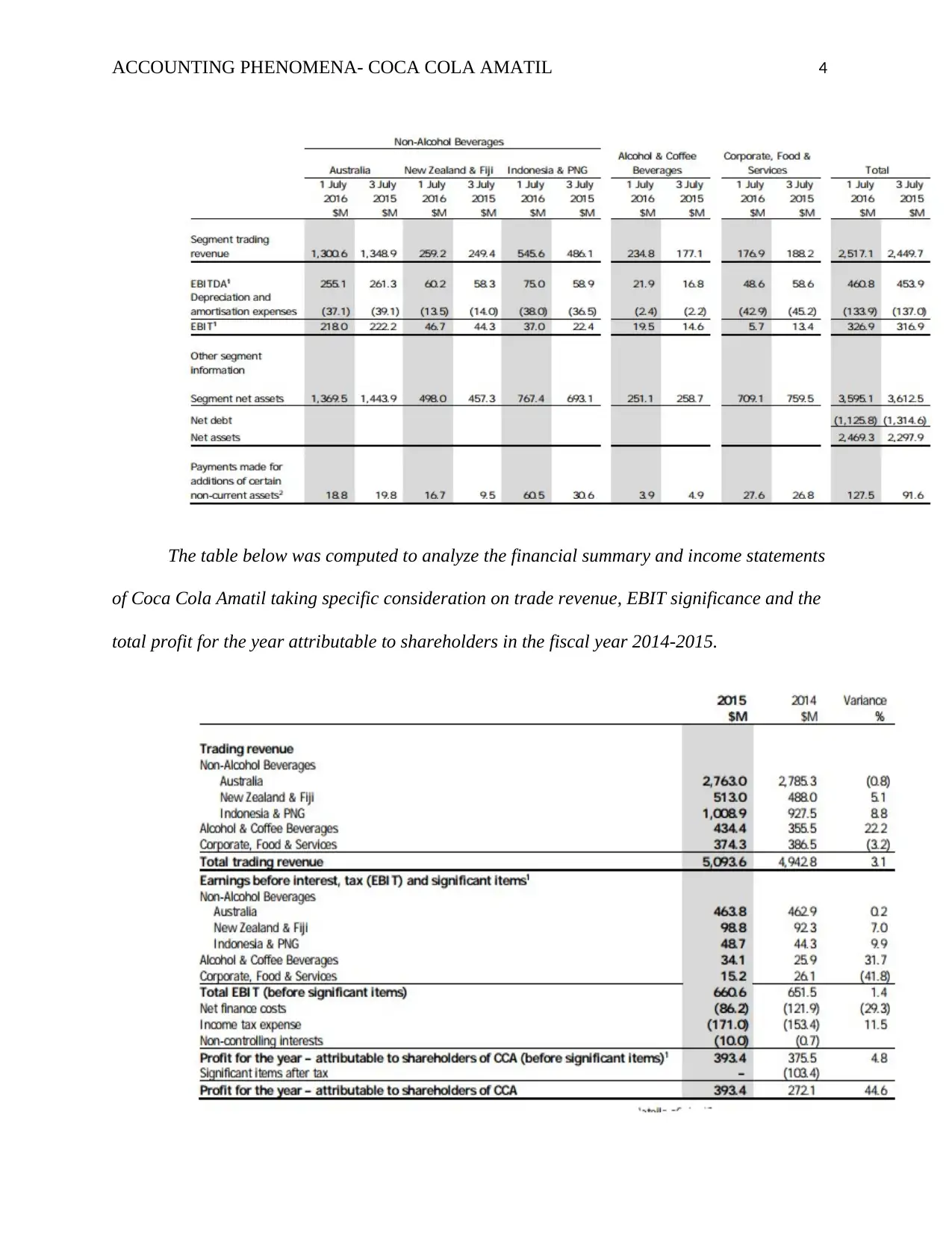
ACCOUNTING PHENOMENA- COCA COLA AMATIL 4
The table below was computed to analyze the financial summary and income statements
of Coca Cola Amatil taking specific consideration on trade revenue, EBIT significance and the
total profit for the year attributable to shareholders in the fiscal year 2014-2015.
The table below was computed to analyze the financial summary and income statements
of Coca Cola Amatil taking specific consideration on trade revenue, EBIT significance and the
total profit for the year attributable to shareholders in the fiscal year 2014-2015.
Secure Best Marks with AI Grader
Need help grading? Try our AI Grader for instant feedback on your assignments.
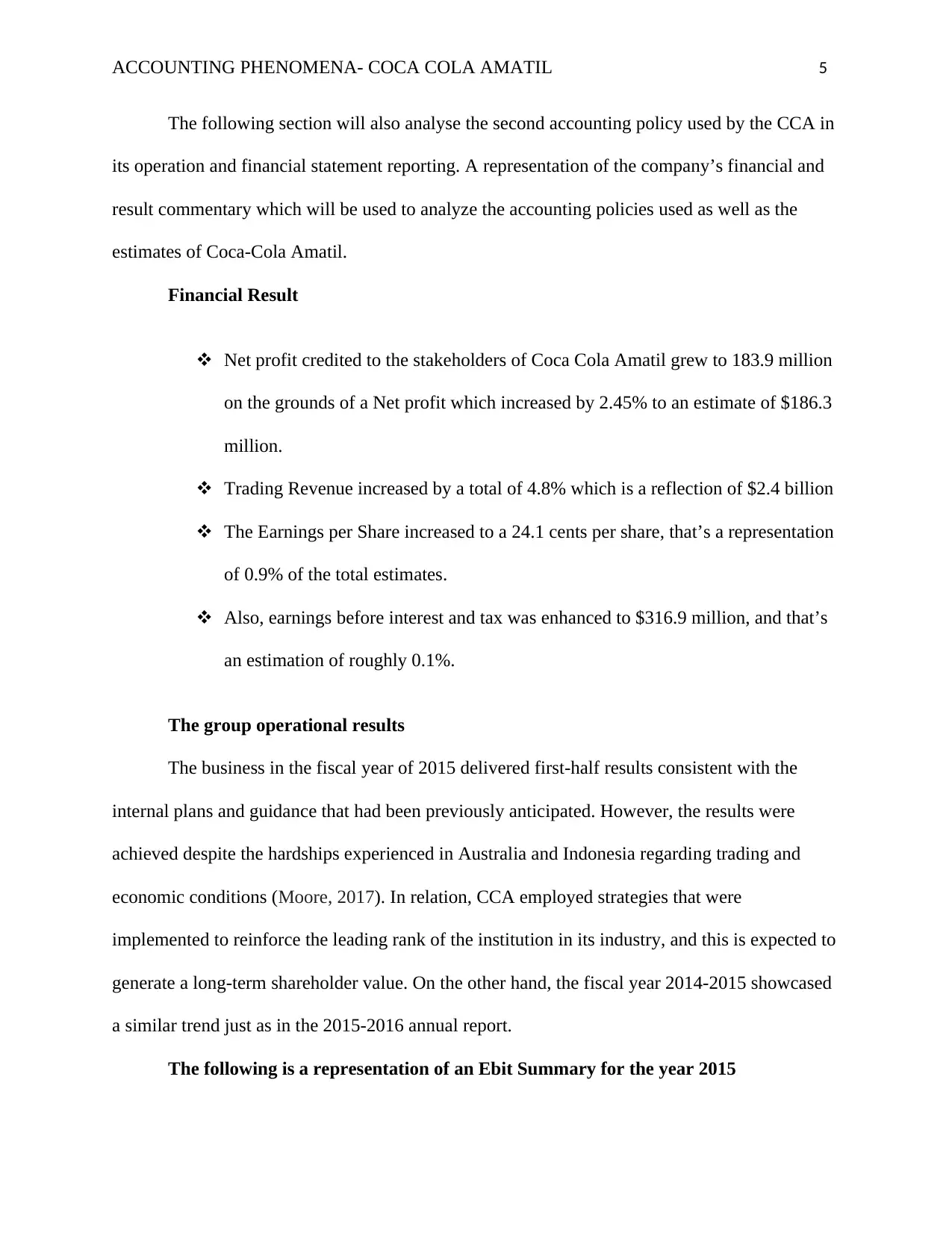
ACCOUNTING PHENOMENA- COCA COLA AMATIL 5
The following section will also analyse the second accounting policy used by the CCA in
its operation and financial statement reporting. A representation of the company’s financial and
result commentary which will be used to analyze the accounting policies used as well as the
estimates of Coca-Cola Amatil.
Financial Result
Net profit credited to the stakeholders of Coca Cola Amatil grew to 183.9 million
on the grounds of a Net profit which increased by 2.45% to an estimate of $186.3
million.
Trading Revenue increased by a total of 4.8% which is a reflection of $2.4 billion
The Earnings per Share increased to a 24.1 cents per share, that’s a representation
of 0.9% of the total estimates.
Also, earnings before interest and tax was enhanced to $316.9 million, and that’s
an estimation of roughly 0.1%.
The group operational results
The business in the fiscal year of 2015 delivered first-half results consistent with the
internal plans and guidance that had been previously anticipated. However, the results were
achieved despite the hardships experienced in Australia and Indonesia regarding trading and
economic conditions (Moore, 2017). In relation, CCA employed strategies that were
implemented to reinforce the leading rank of the institution in its industry, and this is expected to
generate a long-term shareholder value. On the other hand, the fiscal year 2014-2015 showcased
a similar trend just as in the 2015-2016 annual report.
The following is a representation of an Ebit Summary for the year 2015
The following section will also analyse the second accounting policy used by the CCA in
its operation and financial statement reporting. A representation of the company’s financial and
result commentary which will be used to analyze the accounting policies used as well as the
estimates of Coca-Cola Amatil.
Financial Result
Net profit credited to the stakeholders of Coca Cola Amatil grew to 183.9 million
on the grounds of a Net profit which increased by 2.45% to an estimate of $186.3
million.
Trading Revenue increased by a total of 4.8% which is a reflection of $2.4 billion
The Earnings per Share increased to a 24.1 cents per share, that’s a representation
of 0.9% of the total estimates.
Also, earnings before interest and tax was enhanced to $316.9 million, and that’s
an estimation of roughly 0.1%.
The group operational results
The business in the fiscal year of 2015 delivered first-half results consistent with the
internal plans and guidance that had been previously anticipated. However, the results were
achieved despite the hardships experienced in Australia and Indonesia regarding trading and
economic conditions (Moore, 2017). In relation, CCA employed strategies that were
implemented to reinforce the leading rank of the institution in its industry, and this is expected to
generate a long-term shareholder value. On the other hand, the fiscal year 2014-2015 showcased
a similar trend just as in the 2015-2016 annual report.
The following is a representation of an Ebit Summary for the year 2015
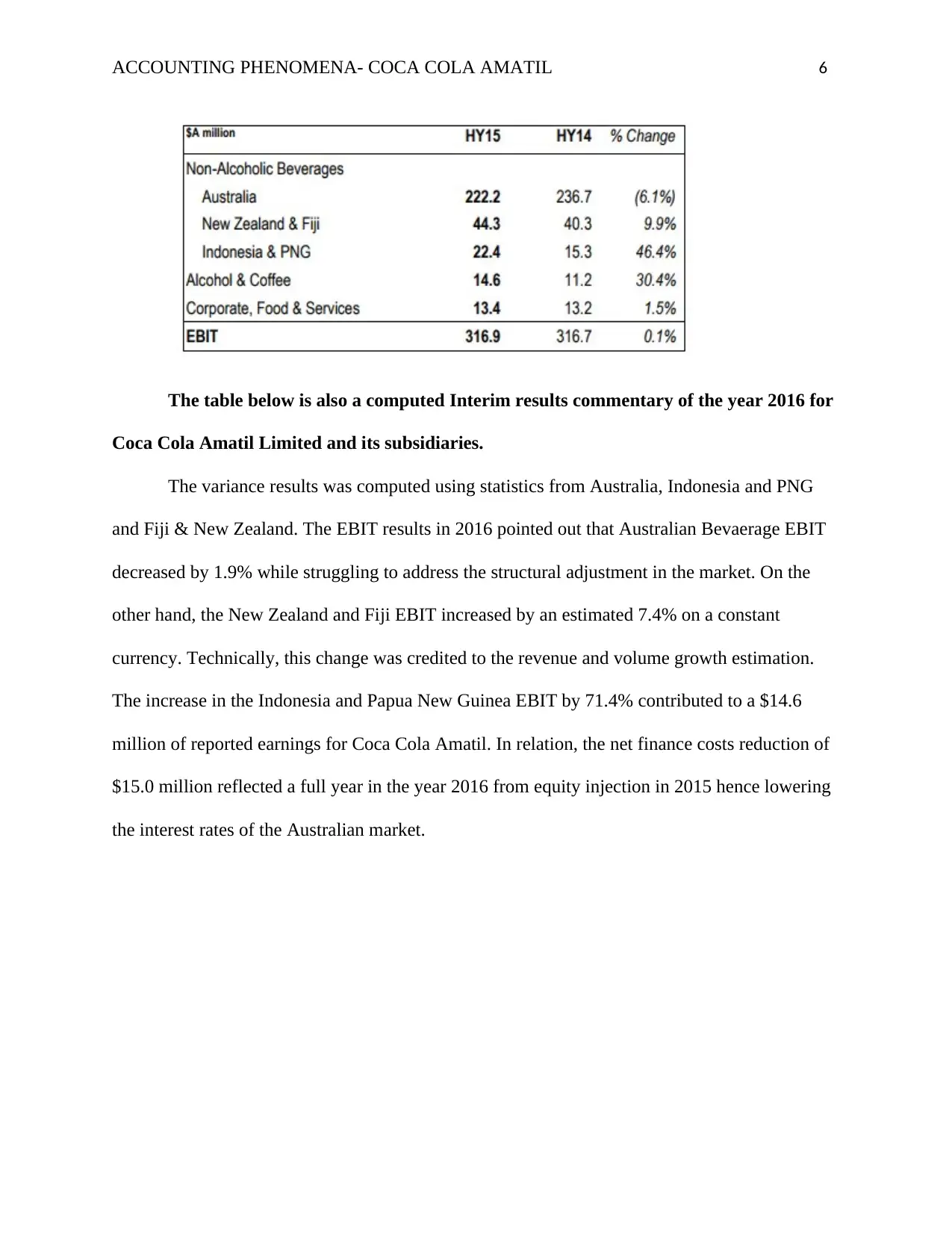
ACCOUNTING PHENOMENA- COCA COLA AMATIL 6
The table below is also a computed Interim results commentary of the year 2016 for
Coca Cola Amatil Limited and its subsidiaries.
The variance results was computed using statistics from Australia, Indonesia and PNG
and Fiji & New Zealand. The EBIT results in 2016 pointed out that Australian Bevaerage EBIT
decreased by 1.9% while struggling to address the structural adjustment in the market. On the
other hand, the New Zealand and Fiji EBIT increased by an estimated 7.4% on a constant
currency. Technically, this change was credited to the revenue and volume growth estimation.
The increase in the Indonesia and Papua New Guinea EBIT by 71.4% contributed to a $14.6
million of reported earnings for Coca Cola Amatil. In relation, the net finance costs reduction of
$15.0 million reflected a full year in the year 2016 from equity injection in 2015 hence lowering
the interest rates of the Australian market.
The table below is also a computed Interim results commentary of the year 2016 for
Coca Cola Amatil Limited and its subsidiaries.
The variance results was computed using statistics from Australia, Indonesia and PNG
and Fiji & New Zealand. The EBIT results in 2016 pointed out that Australian Bevaerage EBIT
decreased by 1.9% while struggling to address the structural adjustment in the market. On the
other hand, the New Zealand and Fiji EBIT increased by an estimated 7.4% on a constant
currency. Technically, this change was credited to the revenue and volume growth estimation.
The increase in the Indonesia and Papua New Guinea EBIT by 71.4% contributed to a $14.6
million of reported earnings for Coca Cola Amatil. In relation, the net finance costs reduction of
$15.0 million reflected a full year in the year 2016 from equity injection in 2015 hence lowering
the interest rates of the Australian market.
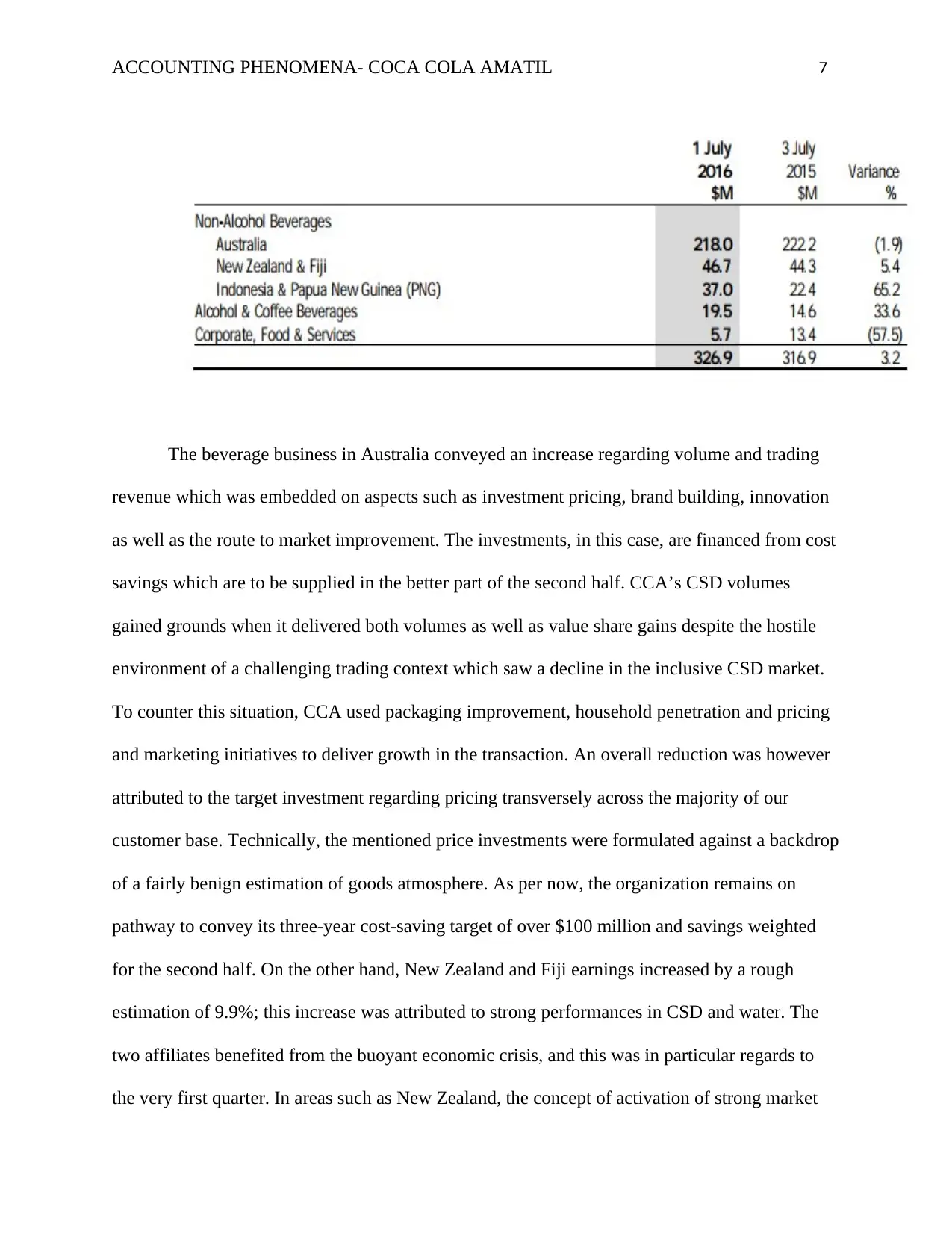
ACCOUNTING PHENOMENA- COCA COLA AMATIL 7
The beverage business in Australia conveyed an increase regarding volume and trading
revenue which was embedded on aspects such as investment pricing, brand building, innovation
as well as the route to market improvement. The investments, in this case, are financed from cost
savings which are to be supplied in the better part of the second half. CCA’s CSD volumes
gained grounds when it delivered both volumes as well as value share gains despite the hostile
environment of a challenging trading context which saw a decline in the inclusive CSD market.
To counter this situation, CCA used packaging improvement, household penetration and pricing
and marketing initiatives to deliver growth in the transaction. An overall reduction was however
attributed to the target investment regarding pricing transversely across the majority of our
customer base. Technically, the mentioned price investments were formulated against a backdrop
of a fairly benign estimation of goods atmosphere. As per now, the organization remains on
pathway to convey its three-year cost-saving target of over $100 million and savings weighted
for the second half. On the other hand, New Zealand and Fiji earnings increased by a rough
estimation of 9.9%; this increase was attributed to strong performances in CSD and water. The
two affiliates benefited from the buoyant economic crisis, and this was in particular regards to
the very first quarter. In areas such as New Zealand, the concept of activation of strong market
The beverage business in Australia conveyed an increase regarding volume and trading
revenue which was embedded on aspects such as investment pricing, brand building, innovation
as well as the route to market improvement. The investments, in this case, are financed from cost
savings which are to be supplied in the better part of the second half. CCA’s CSD volumes
gained grounds when it delivered both volumes as well as value share gains despite the hostile
environment of a challenging trading context which saw a decline in the inclusive CSD market.
To counter this situation, CCA used packaging improvement, household penetration and pricing
and marketing initiatives to deliver growth in the transaction. An overall reduction was however
attributed to the target investment regarding pricing transversely across the majority of our
customer base. Technically, the mentioned price investments were formulated against a backdrop
of a fairly benign estimation of goods atmosphere. As per now, the organization remains on
pathway to convey its three-year cost-saving target of over $100 million and savings weighted
for the second half. On the other hand, New Zealand and Fiji earnings increased by a rough
estimation of 9.9%; this increase was attributed to strong performances in CSD and water. The
two affiliates benefited from the buoyant economic crisis, and this was in particular regards to
the very first quarter. In areas such as New Zealand, the concept of activation of strong market
Paraphrase This Document
Need a fresh take? Get an instant paraphrase of this document with our AI Paraphraser
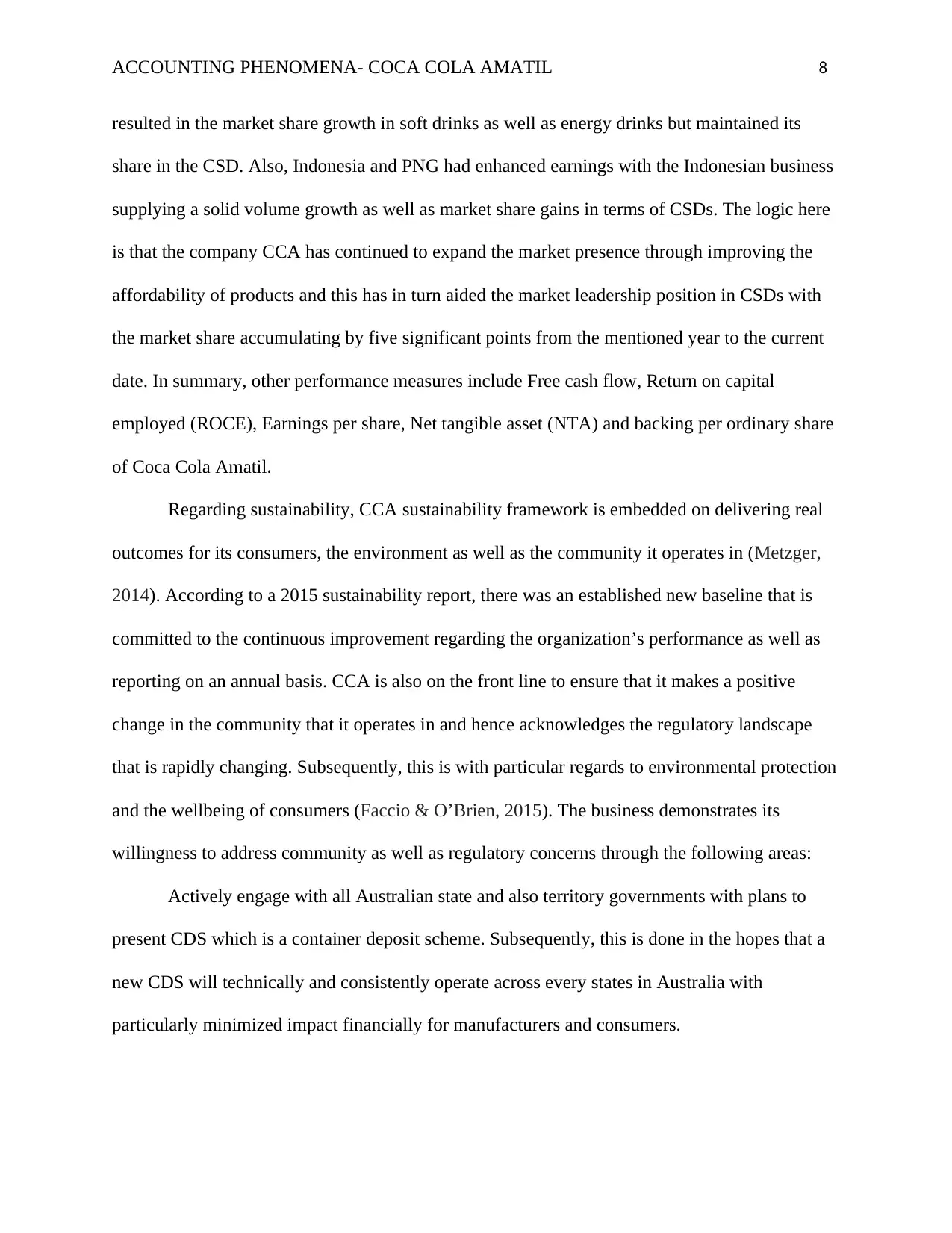
ACCOUNTING PHENOMENA- COCA COLA AMATIL 8
resulted in the market share growth in soft drinks as well as energy drinks but maintained its
share in the CSD. Also, Indonesia and PNG had enhanced earnings with the Indonesian business
supplying a solid volume growth as well as market share gains in terms of CSDs. The logic here
is that the company CCA has continued to expand the market presence through improving the
affordability of products and this has in turn aided the market leadership position in CSDs with
the market share accumulating by five significant points from the mentioned year to the current
date. In summary, other performance measures include Free cash flow, Return on capital
employed (ROCE), Earnings per share, Net tangible asset (NTA) and backing per ordinary share
of Coca Cola Amatil.
Regarding sustainability, CCA sustainability framework is embedded on delivering real
outcomes for its consumers, the environment as well as the community it operates in (Metzger,
2014). According to a 2015 sustainability report, there was an established new baseline that is
committed to the continuous improvement regarding the organization’s performance as well as
reporting on an annual basis. CCA is also on the front line to ensure that it makes a positive
change in the community that it operates in and hence acknowledges the regulatory landscape
that is rapidly changing. Subsequently, this is with particular regards to environmental protection
and the wellbeing of consumers (Faccio & O’Brien, 2015). The business demonstrates its
willingness to address community as well as regulatory concerns through the following areas:
Actively engage with all Australian state and also territory governments with plans to
present CDS which is a container deposit scheme. Subsequently, this is done in the hopes that a
new CDS will technically and consistently operate across every states in Australia with
particularly minimized impact financially for manufacturers and consumers.
resulted in the market share growth in soft drinks as well as energy drinks but maintained its
share in the CSD. Also, Indonesia and PNG had enhanced earnings with the Indonesian business
supplying a solid volume growth as well as market share gains in terms of CSDs. The logic here
is that the company CCA has continued to expand the market presence through improving the
affordability of products and this has in turn aided the market leadership position in CSDs with
the market share accumulating by five significant points from the mentioned year to the current
date. In summary, other performance measures include Free cash flow, Return on capital
employed (ROCE), Earnings per share, Net tangible asset (NTA) and backing per ordinary share
of Coca Cola Amatil.
Regarding sustainability, CCA sustainability framework is embedded on delivering real
outcomes for its consumers, the environment as well as the community it operates in (Metzger,
2014). According to a 2015 sustainability report, there was an established new baseline that is
committed to the continuous improvement regarding the organization’s performance as well as
reporting on an annual basis. CCA is also on the front line to ensure that it makes a positive
change in the community that it operates in and hence acknowledges the regulatory landscape
that is rapidly changing. Subsequently, this is with particular regards to environmental protection
and the wellbeing of consumers (Faccio & O’Brien, 2015). The business demonstrates its
willingness to address community as well as regulatory concerns through the following areas:
Actively engage with all Australian state and also territory governments with plans to
present CDS which is a container deposit scheme. Subsequently, this is done in the hopes that a
new CDS will technically and consistently operate across every states in Australia with
particularly minimized impact financially for manufacturers and consumers.
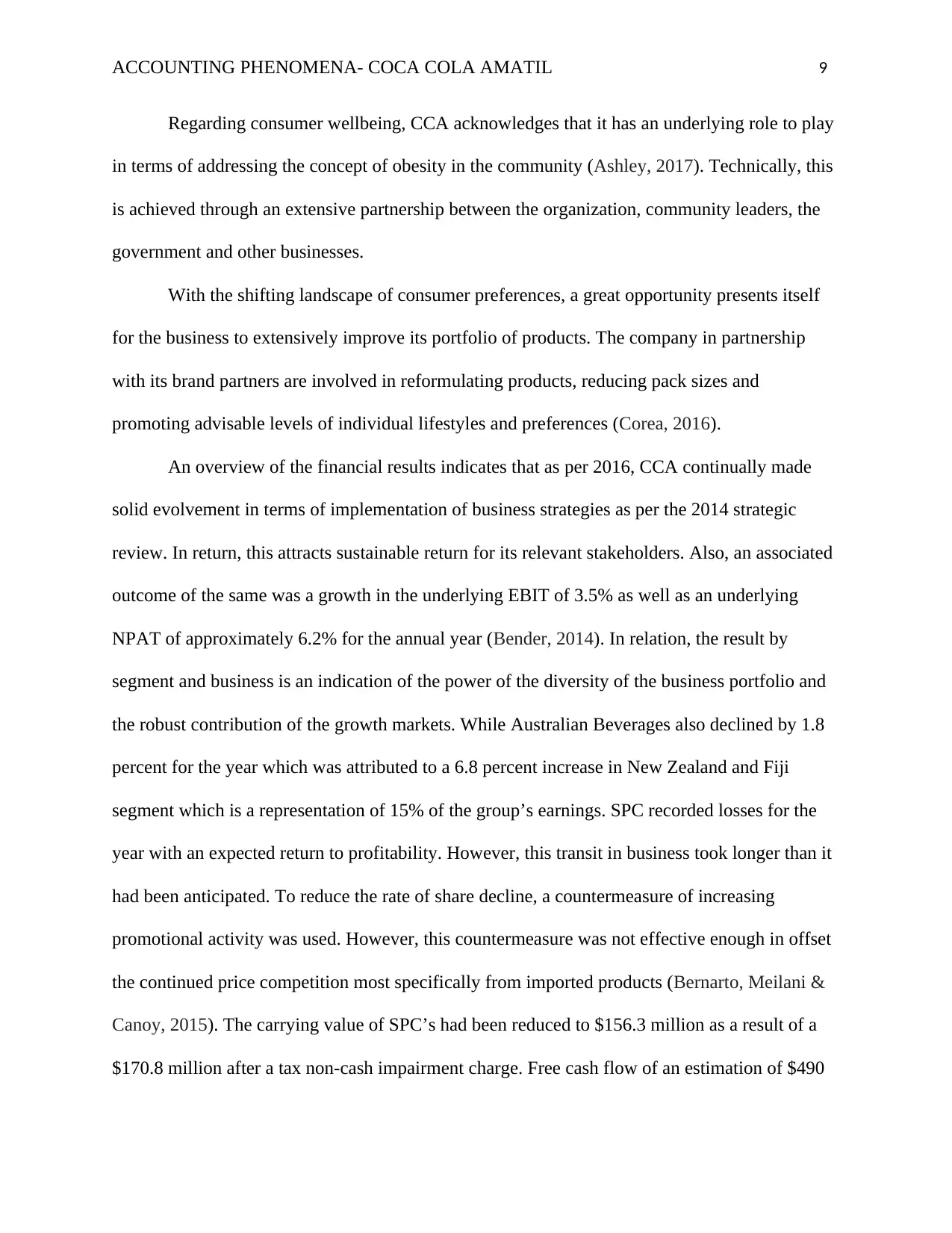
ACCOUNTING PHENOMENA- COCA COLA AMATIL 9
Regarding consumer wellbeing, CCA acknowledges that it has an underlying role to play
in terms of addressing the concept of obesity in the community (Ashley, 2017). Technically, this
is achieved through an extensive partnership between the organization, community leaders, the
government and other businesses.
With the shifting landscape of consumer preferences, a great opportunity presents itself
for the business to extensively improve its portfolio of products. The company in partnership
with its brand partners are involved in reformulating products, reducing pack sizes and
promoting advisable levels of individual lifestyles and preferences (Corea, 2016).
An overview of the financial results indicates that as per 2016, CCA continually made
solid evolvement in terms of implementation of business strategies as per the 2014 strategic
review. In return, this attracts sustainable return for its relevant stakeholders. Also, an associated
outcome of the same was a growth in the underlying EBIT of 3.5% as well as an underlying
NPAT of approximately 6.2% for the annual year (Bender, 2014). In relation, the result by
segment and business is an indication of the power of the diversity of the business portfolio and
the robust contribution of the growth markets. While Australian Beverages also declined by 1.8
percent for the year which was attributed to a 6.8 percent increase in New Zealand and Fiji
segment which is a representation of 15% of the group’s earnings. SPC recorded losses for the
year with an expected return to profitability. However, this transit in business took longer than it
had been anticipated. To reduce the rate of share decline, a countermeasure of increasing
promotional activity was used. However, this countermeasure was not effective enough in offset
the continued price competition most specifically from imported products (Bernarto, Meilani &
Canoy, 2015). The carrying value of SPC’s had been reduced to $156.3 million as a result of a
$170.8 million after a tax non-cash impairment charge. Free cash flow of an estimation of $490
Regarding consumer wellbeing, CCA acknowledges that it has an underlying role to play
in terms of addressing the concept of obesity in the community (Ashley, 2017). Technically, this
is achieved through an extensive partnership between the organization, community leaders, the
government and other businesses.
With the shifting landscape of consumer preferences, a great opportunity presents itself
for the business to extensively improve its portfolio of products. The company in partnership
with its brand partners are involved in reformulating products, reducing pack sizes and
promoting advisable levels of individual lifestyles and preferences (Corea, 2016).
An overview of the financial results indicates that as per 2016, CCA continually made
solid evolvement in terms of implementation of business strategies as per the 2014 strategic
review. In return, this attracts sustainable return for its relevant stakeholders. Also, an associated
outcome of the same was a growth in the underlying EBIT of 3.5% as well as an underlying
NPAT of approximately 6.2% for the annual year (Bender, 2014). In relation, the result by
segment and business is an indication of the power of the diversity of the business portfolio and
the robust contribution of the growth markets. While Australian Beverages also declined by 1.8
percent for the year which was attributed to a 6.8 percent increase in New Zealand and Fiji
segment which is a representation of 15% of the group’s earnings. SPC recorded losses for the
year with an expected return to profitability. However, this transit in business took longer than it
had been anticipated. To reduce the rate of share decline, a countermeasure of increasing
promotional activity was used. However, this countermeasure was not effective enough in offset
the continued price competition most specifically from imported products (Bernarto, Meilani &
Canoy, 2015). The carrying value of SPC’s had been reduced to $156.3 million as a result of a
$170.8 million after a tax non-cash impairment charge. Free cash flow of an estimation of $490
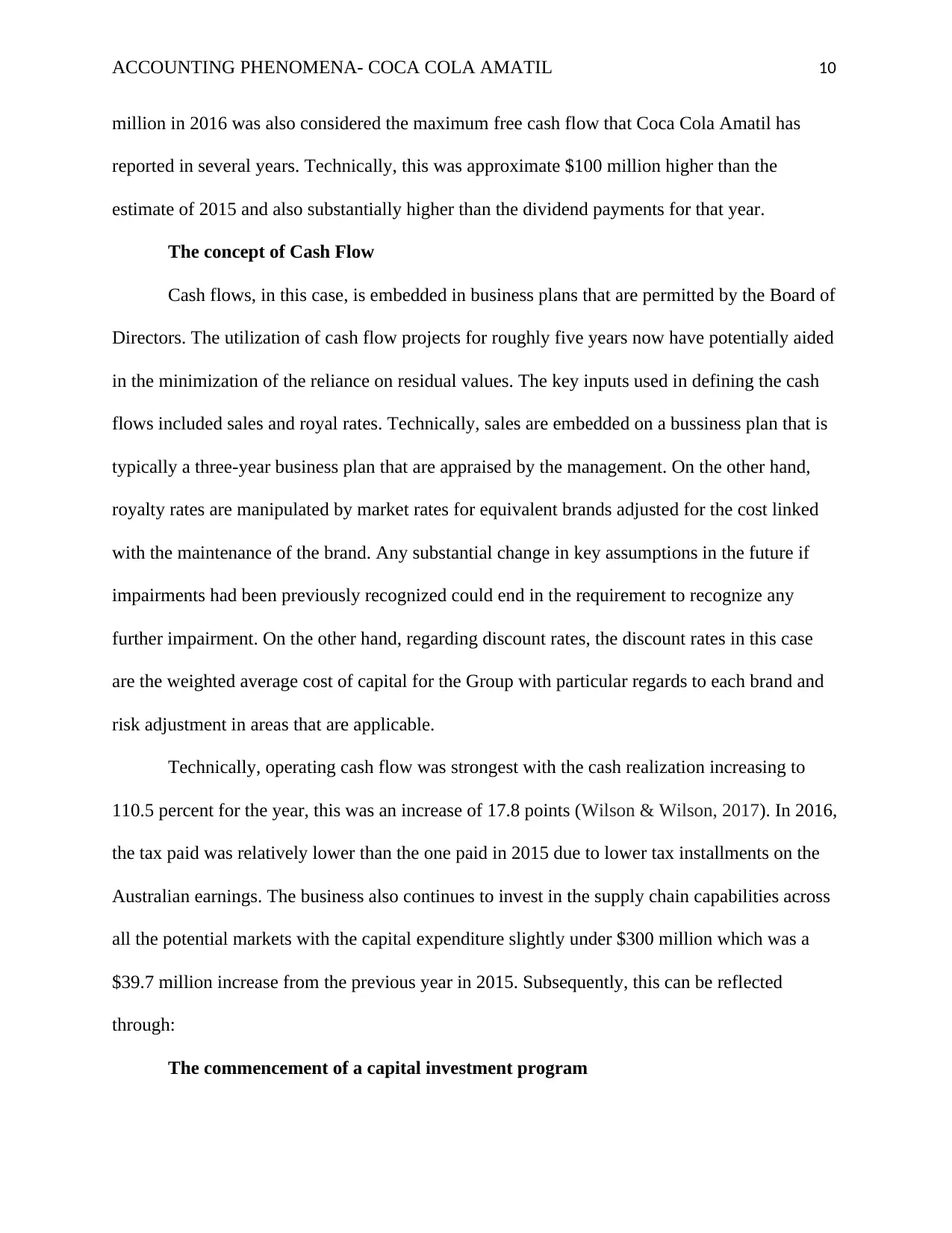
ACCOUNTING PHENOMENA- COCA COLA AMATIL 10
million in 2016 was also considered the maximum free cash flow that Coca Cola Amatil has
reported in several years. Technically, this was approximate $100 million higher than the
estimate of 2015 and also substantially higher than the dividend payments for that year.
The concept of Cash Flow
Cash flows, in this case, is embedded in business plans that are permitted by the Board of
Directors. The utilization of cash flow projects for roughly five years now have potentially aided
in the minimization of the reliance on residual values. The key inputs used in defining the cash
flows included sales and royal rates. Technically, sales are embedded on a bussiness plan that is
typically a three-year business plan that are appraised by the management. On the other hand,
royalty rates are manipulated by market rates for equivalent brands adjusted for the cost linked
with the maintenance of the brand. Any substantial change in key assumptions in the future if
impairments had been previously recognized could end in the requirement to recognize any
further impairment. On the other hand, regarding discount rates, the discount rates in this case
are the weighted average cost of capital for the Group with particular regards to each brand and
risk adjustment in areas that are applicable.
Technically, operating cash flow was strongest with the cash realization increasing to
110.5 percent for the year, this was an increase of 17.8 points (Wilson & Wilson, 2017). In 2016,
the tax paid was relatively lower than the one paid in 2015 due to lower tax installments on the
Australian earnings. The business also continues to invest in the supply chain capabilities across
all the potential markets with the capital expenditure slightly under $300 million which was a
$39.7 million increase from the previous year in 2015. Subsequently, this can be reflected
through:
The commencement of a capital investment program
million in 2016 was also considered the maximum free cash flow that Coca Cola Amatil has
reported in several years. Technically, this was approximate $100 million higher than the
estimate of 2015 and also substantially higher than the dividend payments for that year.
The concept of Cash Flow
Cash flows, in this case, is embedded in business plans that are permitted by the Board of
Directors. The utilization of cash flow projects for roughly five years now have potentially aided
in the minimization of the reliance on residual values. The key inputs used in defining the cash
flows included sales and royal rates. Technically, sales are embedded on a bussiness plan that is
typically a three-year business plan that are appraised by the management. On the other hand,
royalty rates are manipulated by market rates for equivalent brands adjusted for the cost linked
with the maintenance of the brand. Any substantial change in key assumptions in the future if
impairments had been previously recognized could end in the requirement to recognize any
further impairment. On the other hand, regarding discount rates, the discount rates in this case
are the weighted average cost of capital for the Group with particular regards to each brand and
risk adjustment in areas that are applicable.
Technically, operating cash flow was strongest with the cash realization increasing to
110.5 percent for the year, this was an increase of 17.8 points (Wilson & Wilson, 2017). In 2016,
the tax paid was relatively lower than the one paid in 2015 due to lower tax installments on the
Australian earnings. The business also continues to invest in the supply chain capabilities across
all the potential markets with the capital expenditure slightly under $300 million which was a
$39.7 million increase from the previous year in 2015. Subsequently, this can be reflected
through:
The commencement of a capital investment program
Secure Best Marks with AI Grader
Need help grading? Try our AI Grader for instant feedback on your assignments.
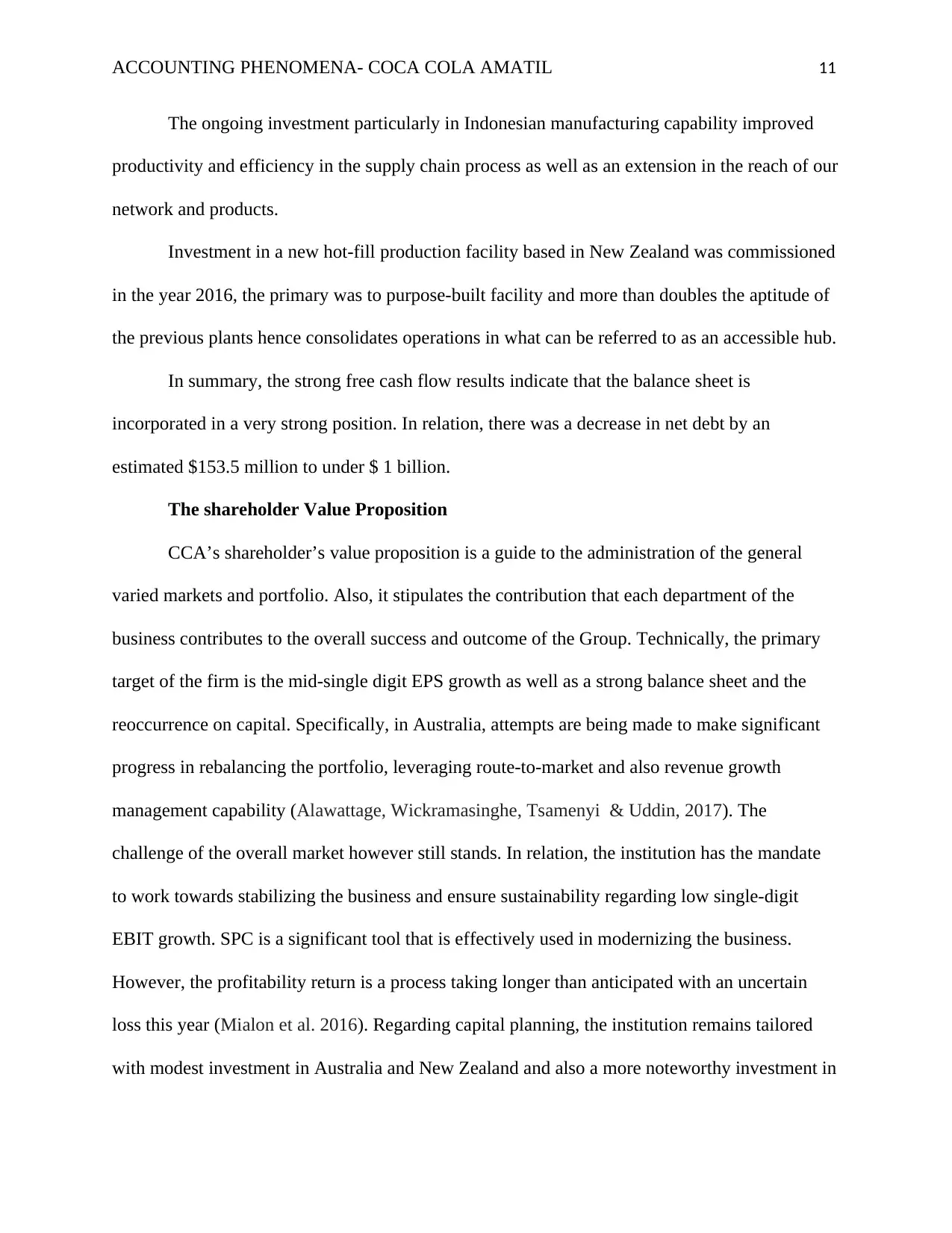
ACCOUNTING PHENOMENA- COCA COLA AMATIL 11
The ongoing investment particularly in Indonesian manufacturing capability improved
productivity and efficiency in the supply chain process as well as an extension in the reach of our
network and products.
Investment in a new hot-fill production facility based in New Zealand was commissioned
in the year 2016, the primary was to purpose-built facility and more than doubles the aptitude of
the previous plants hence consolidates operations in what can be referred to as an accessible hub.
In summary, the strong free cash flow results indicate that the balance sheet is
incorporated in a very strong position. In relation, there was a decrease in net debt by an
estimated $153.5 million to under $ 1 billion.
The shareholder Value Proposition
CCA’s shareholder’s value proposition is a guide to the administration of the general
varied markets and portfolio. Also, it stipulates the contribution that each department of the
business contributes to the overall success and outcome of the Group. Technically, the primary
target of the firm is the mid-single digit EPS growth as well as a strong balance sheet and the
reoccurrence on capital. Specifically, in Australia, attempts are being made to make significant
progress in rebalancing the portfolio, leveraging route-to-market and also revenue growth
management capability (Alawattage, Wickramasinghe, Tsamenyi & Uddin, 2017). The
challenge of the overall market however still stands. In relation, the institution has the mandate
to work towards stabilizing the business and ensure sustainability regarding low single-digit
EBIT growth. SPC is a significant tool that is effectively used in modernizing the business.
However, the profitability return is a process taking longer than anticipated with an uncertain
loss this year (Mialon et al. 2016). Regarding capital planning, the institution remains tailored
with modest investment in Australia and New Zealand and also a more noteworthy investment in
The ongoing investment particularly in Indonesian manufacturing capability improved
productivity and efficiency in the supply chain process as well as an extension in the reach of our
network and products.
Investment in a new hot-fill production facility based in New Zealand was commissioned
in the year 2016, the primary was to purpose-built facility and more than doubles the aptitude of
the previous plants hence consolidates operations in what can be referred to as an accessible hub.
In summary, the strong free cash flow results indicate that the balance sheet is
incorporated in a very strong position. In relation, there was a decrease in net debt by an
estimated $153.5 million to under $ 1 billion.
The shareholder Value Proposition
CCA’s shareholder’s value proposition is a guide to the administration of the general
varied markets and portfolio. Also, it stipulates the contribution that each department of the
business contributes to the overall success and outcome of the Group. Technically, the primary
target of the firm is the mid-single digit EPS growth as well as a strong balance sheet and the
reoccurrence on capital. Specifically, in Australia, attempts are being made to make significant
progress in rebalancing the portfolio, leveraging route-to-market and also revenue growth
management capability (Alawattage, Wickramasinghe, Tsamenyi & Uddin, 2017). The
challenge of the overall market however still stands. In relation, the institution has the mandate
to work towards stabilizing the business and ensure sustainability regarding low single-digit
EBIT growth. SPC is a significant tool that is effectively used in modernizing the business.
However, the profitability return is a process taking longer than anticipated with an uncertain
loss this year (Mialon et al. 2016). Regarding capital planning, the institution remains tailored
with modest investment in Australia and New Zealand and also a more noteworthy investment in
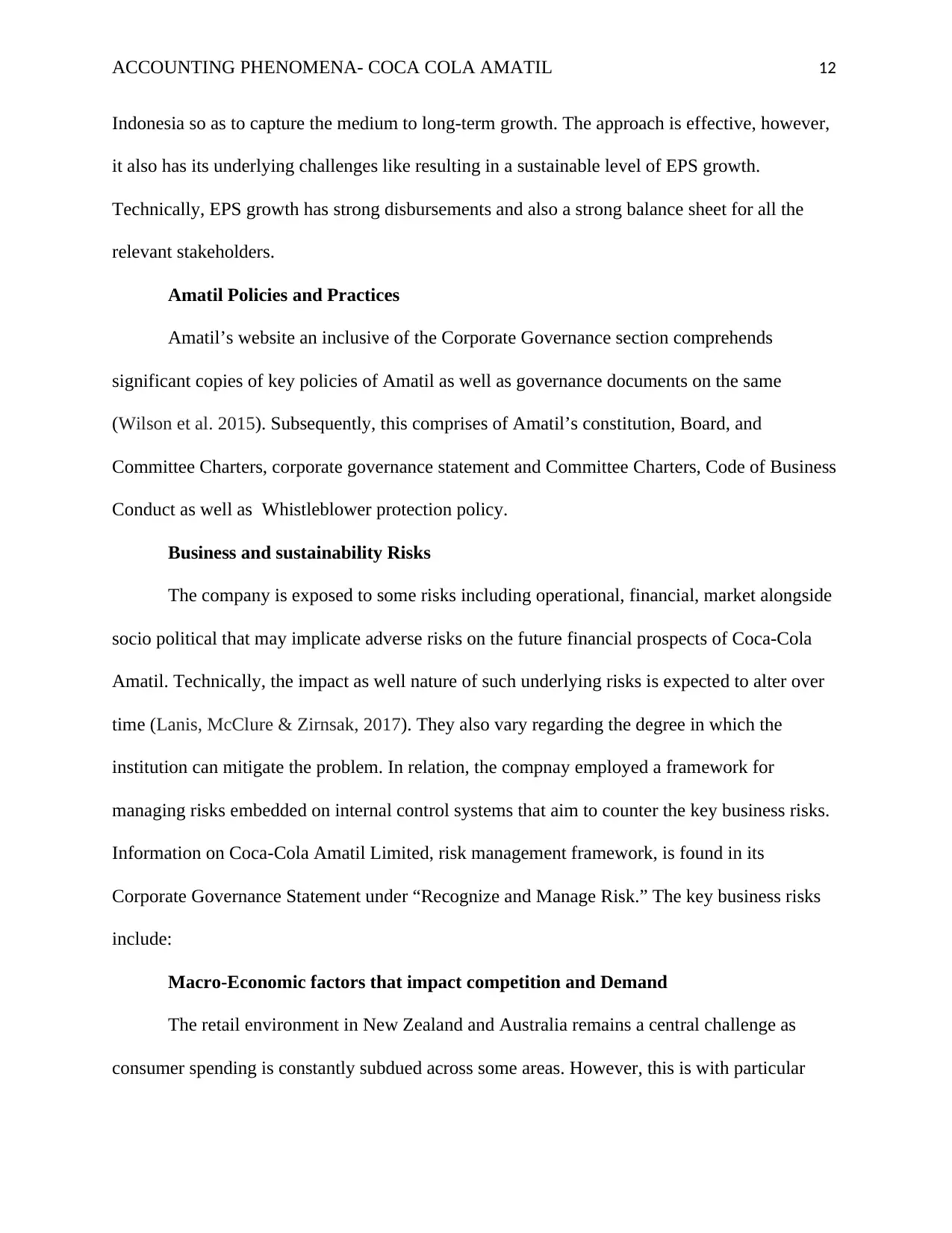
ACCOUNTING PHENOMENA- COCA COLA AMATIL 12
Indonesia so as to capture the medium to long-term growth. The approach is effective, however,
it also has its underlying challenges like resulting in a sustainable level of EPS growth.
Technically, EPS growth has strong disbursements and also a strong balance sheet for all the
relevant stakeholders.
Amatil Policies and Practices
Amatil’s website an inclusive of the Corporate Governance section comprehends
significant copies of key policies of Amatil as well as governance documents on the same
(Wilson et al. 2015). Subsequently, this comprises of Amatil’s constitution, Board, and
Committee Charters, corporate governance statement and Committee Charters, Code of Business
Conduct as well as Whistleblower protection policy.
Business and sustainability Risks
The company is exposed to some risks including operational, financial, market alongside
socio political that may implicate adverse risks on the future financial prospects of Coca-Cola
Amatil. Technically, the impact as well nature of such underlying risks is expected to alter over
time (Lanis, McClure & Zirnsak, 2017). They also vary regarding the degree in which the
institution can mitigate the problem. In relation, the compnay employed a framework for
managing risks embedded on internal control systems that aim to counter the key business risks.
Information on Coca-Cola Amatil Limited, risk management framework, is found in its
Corporate Governance Statement under “Recognize and Manage Risk.” The key business risks
include:
Macro-Economic factors that impact competition and Demand
The retail environment in New Zealand and Australia remains a central challenge as
consumer spending is constantly subdued across some areas. However, this is with particular
Indonesia so as to capture the medium to long-term growth. The approach is effective, however,
it also has its underlying challenges like resulting in a sustainable level of EPS growth.
Technically, EPS growth has strong disbursements and also a strong balance sheet for all the
relevant stakeholders.
Amatil Policies and Practices
Amatil’s website an inclusive of the Corporate Governance section comprehends
significant copies of key policies of Amatil as well as governance documents on the same
(Wilson et al. 2015). Subsequently, this comprises of Amatil’s constitution, Board, and
Committee Charters, corporate governance statement and Committee Charters, Code of Business
Conduct as well as Whistleblower protection policy.
Business and sustainability Risks
The company is exposed to some risks including operational, financial, market alongside
socio political that may implicate adverse risks on the future financial prospects of Coca-Cola
Amatil. Technically, the impact as well nature of such underlying risks is expected to alter over
time (Lanis, McClure & Zirnsak, 2017). They also vary regarding the degree in which the
institution can mitigate the problem. In relation, the compnay employed a framework for
managing risks embedded on internal control systems that aim to counter the key business risks.
Information on Coca-Cola Amatil Limited, risk management framework, is found in its
Corporate Governance Statement under “Recognize and Manage Risk.” The key business risks
include:
Macro-Economic factors that impact competition and Demand
The retail environment in New Zealand and Australia remains a central challenge as
consumer spending is constantly subdued across some areas. However, this is with particular
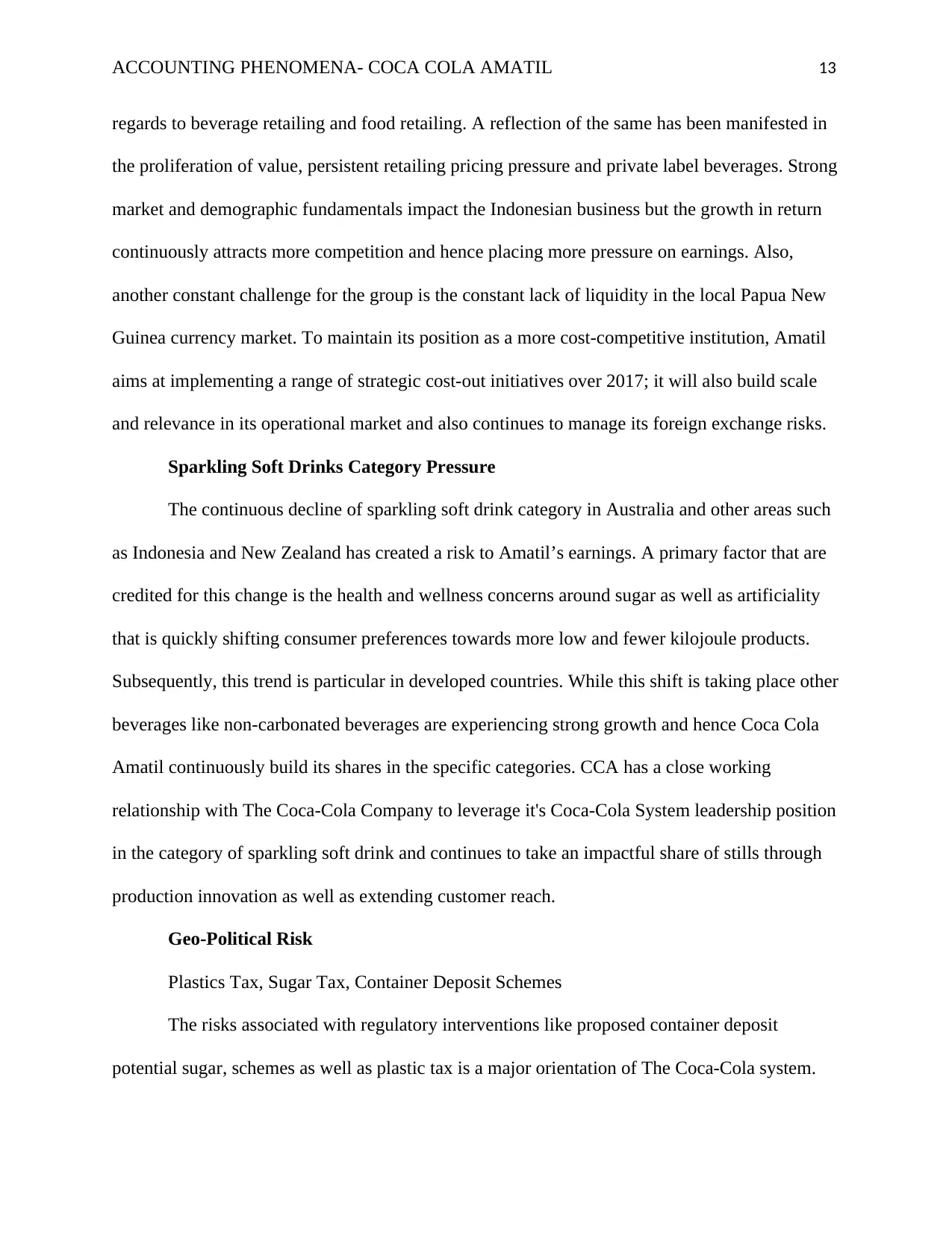
ACCOUNTING PHENOMENA- COCA COLA AMATIL 13
regards to beverage retailing and food retailing. A reflection of the same has been manifested in
the proliferation of value, persistent retailing pricing pressure and private label beverages. Strong
market and demographic fundamentals impact the Indonesian business but the growth in return
continuously attracts more competition and hence placing more pressure on earnings. Also,
another constant challenge for the group is the constant lack of liquidity in the local Papua New
Guinea currency market. To maintain its position as a more cost-competitive institution, Amatil
aims at implementing a range of strategic cost-out initiatives over 2017; it will also build scale
and relevance in its operational market and also continues to manage its foreign exchange risks.
Sparkling Soft Drinks Category Pressure
The continuous decline of sparkling soft drink category in Australia and other areas such
as Indonesia and New Zealand has created a risk to Amatil’s earnings. A primary factor that are
credited for this change is the health and wellness concerns around sugar as well as artificiality
that is quickly shifting consumer preferences towards more low and fewer kilojoule products.
Subsequently, this trend is particular in developed countries. While this shift is taking place other
beverages like non-carbonated beverages are experiencing strong growth and hence Coca Cola
Amatil continuously build its shares in the specific categories. CCA has a close working
relationship with The Coca-Cola Company to leverage it's Coca-Cola System leadership position
in the category of sparkling soft drink and continues to take an impactful share of stills through
production innovation as well as extending customer reach.
Geo-Political Risk
Plastics Tax, Sugar Tax, Container Deposit Schemes
The risks associated with regulatory interventions like proposed container deposit
potential sugar, schemes as well as plastic tax is a major orientation of The Coca-Cola system.
regards to beverage retailing and food retailing. A reflection of the same has been manifested in
the proliferation of value, persistent retailing pricing pressure and private label beverages. Strong
market and demographic fundamentals impact the Indonesian business but the growth in return
continuously attracts more competition and hence placing more pressure on earnings. Also,
another constant challenge for the group is the constant lack of liquidity in the local Papua New
Guinea currency market. To maintain its position as a more cost-competitive institution, Amatil
aims at implementing a range of strategic cost-out initiatives over 2017; it will also build scale
and relevance in its operational market and also continues to manage its foreign exchange risks.
Sparkling Soft Drinks Category Pressure
The continuous decline of sparkling soft drink category in Australia and other areas such
as Indonesia and New Zealand has created a risk to Amatil’s earnings. A primary factor that are
credited for this change is the health and wellness concerns around sugar as well as artificiality
that is quickly shifting consumer preferences towards more low and fewer kilojoule products.
Subsequently, this trend is particular in developed countries. While this shift is taking place other
beverages like non-carbonated beverages are experiencing strong growth and hence Coca Cola
Amatil continuously build its shares in the specific categories. CCA has a close working
relationship with The Coca-Cola Company to leverage it's Coca-Cola System leadership position
in the category of sparkling soft drink and continues to take an impactful share of stills through
production innovation as well as extending customer reach.
Geo-Political Risk
Plastics Tax, Sugar Tax, Container Deposit Schemes
The risks associated with regulatory interventions like proposed container deposit
potential sugar, schemes as well as plastic tax is a major orientation of The Coca-Cola system.
Paraphrase This Document
Need a fresh take? Get an instant paraphrase of this document with our AI Paraphraser
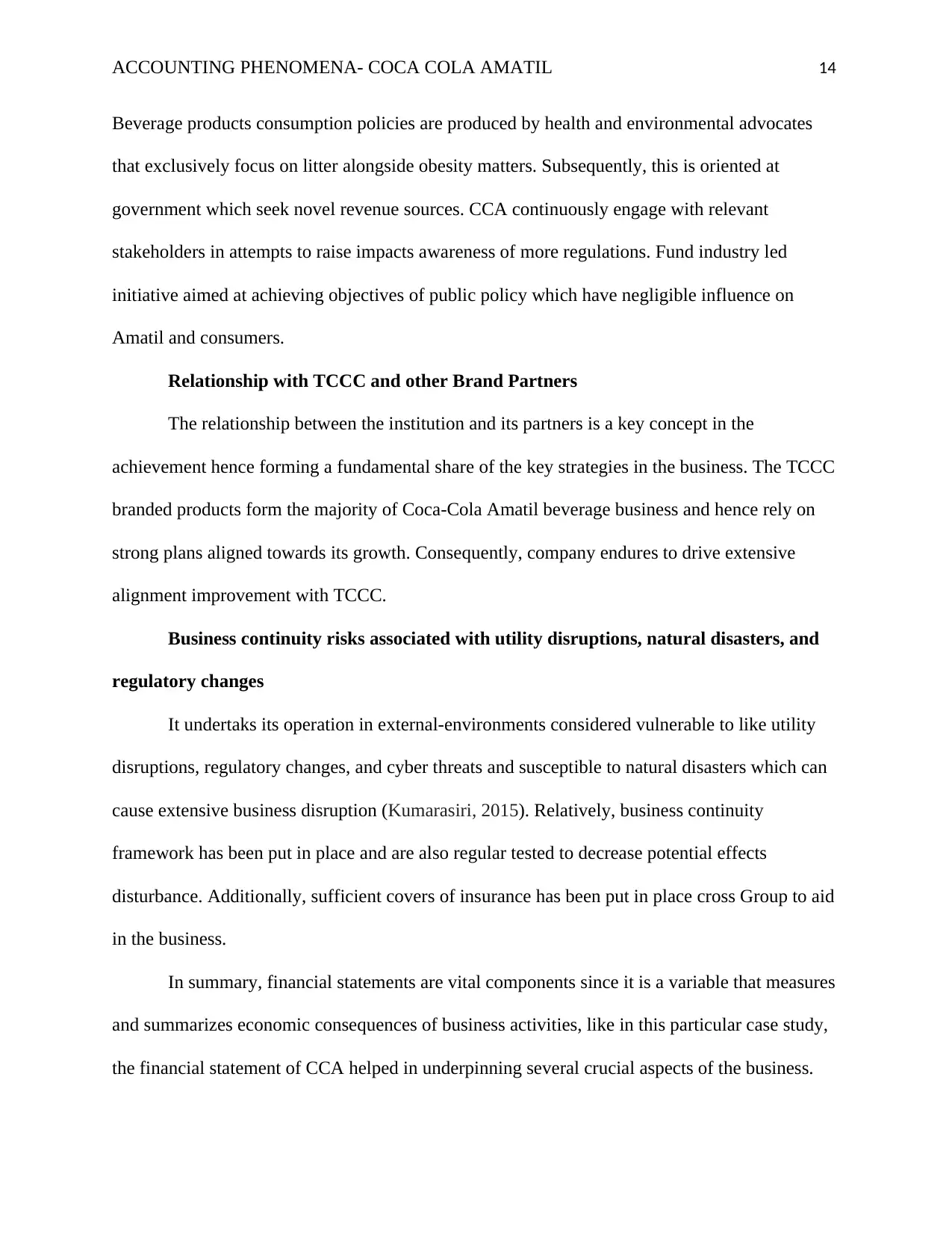
ACCOUNTING PHENOMENA- COCA COLA AMATIL 14
Beverage products consumption policies are produced by health and environmental advocates
that exclusively focus on litter alongside obesity matters. Subsequently, this is oriented at
government which seek novel revenue sources. CCA continuously engage with relevant
stakeholders in attempts to raise impacts awareness of more regulations. Fund industry led
initiative aimed at achieving objectives of public policy which have negligible influence on
Amatil and consumers.
Relationship with TCCC and other Brand Partners
The relationship between the institution and its partners is a key concept in the
achievement hence forming a fundamental share of the key strategies in the business. The TCCC
branded products form the majority of Coca-Cola Amatil beverage business and hence rely on
strong plans aligned towards its growth. Consequently, company endures to drive extensive
alignment improvement with TCCC.
Business continuity risks associated with utility disruptions, natural disasters, and
regulatory changes
It undertaks its operation in external-environments considered vulnerable to like utility
disruptions, regulatory changes, and cyber threats and susceptible to natural disasters which can
cause extensive business disruption (Kumarasiri, 2015). Relatively, business continuity
framework has been put in place and are also regular tested to decrease potential effects
disturbance. Additionally, sufficient covers of insurance has been put in place cross Group to aid
in the business.
In summary, financial statements are vital components since it is a variable that measures
and summarizes economic consequences of business activities, like in this particular case study,
the financial statement of CCA helped in underpinning several crucial aspects of the business.
Beverage products consumption policies are produced by health and environmental advocates
that exclusively focus on litter alongside obesity matters. Subsequently, this is oriented at
government which seek novel revenue sources. CCA continuously engage with relevant
stakeholders in attempts to raise impacts awareness of more regulations. Fund industry led
initiative aimed at achieving objectives of public policy which have negligible influence on
Amatil and consumers.
Relationship with TCCC and other Brand Partners
The relationship between the institution and its partners is a key concept in the
achievement hence forming a fundamental share of the key strategies in the business. The TCCC
branded products form the majority of Coca-Cola Amatil beverage business and hence rely on
strong plans aligned towards its growth. Consequently, company endures to drive extensive
alignment improvement with TCCC.
Business continuity risks associated with utility disruptions, natural disasters, and
regulatory changes
It undertaks its operation in external-environments considered vulnerable to like utility
disruptions, regulatory changes, and cyber threats and susceptible to natural disasters which can
cause extensive business disruption (Kumarasiri, 2015). Relatively, business continuity
framework has been put in place and are also regular tested to decrease potential effects
disturbance. Additionally, sufficient covers of insurance has been put in place cross Group to aid
in the business.
In summary, financial statements are vital components since it is a variable that measures
and summarizes economic consequences of business activities, like in this particular case study,
the financial statement of CCA helped in underpinning several crucial aspects of the business.
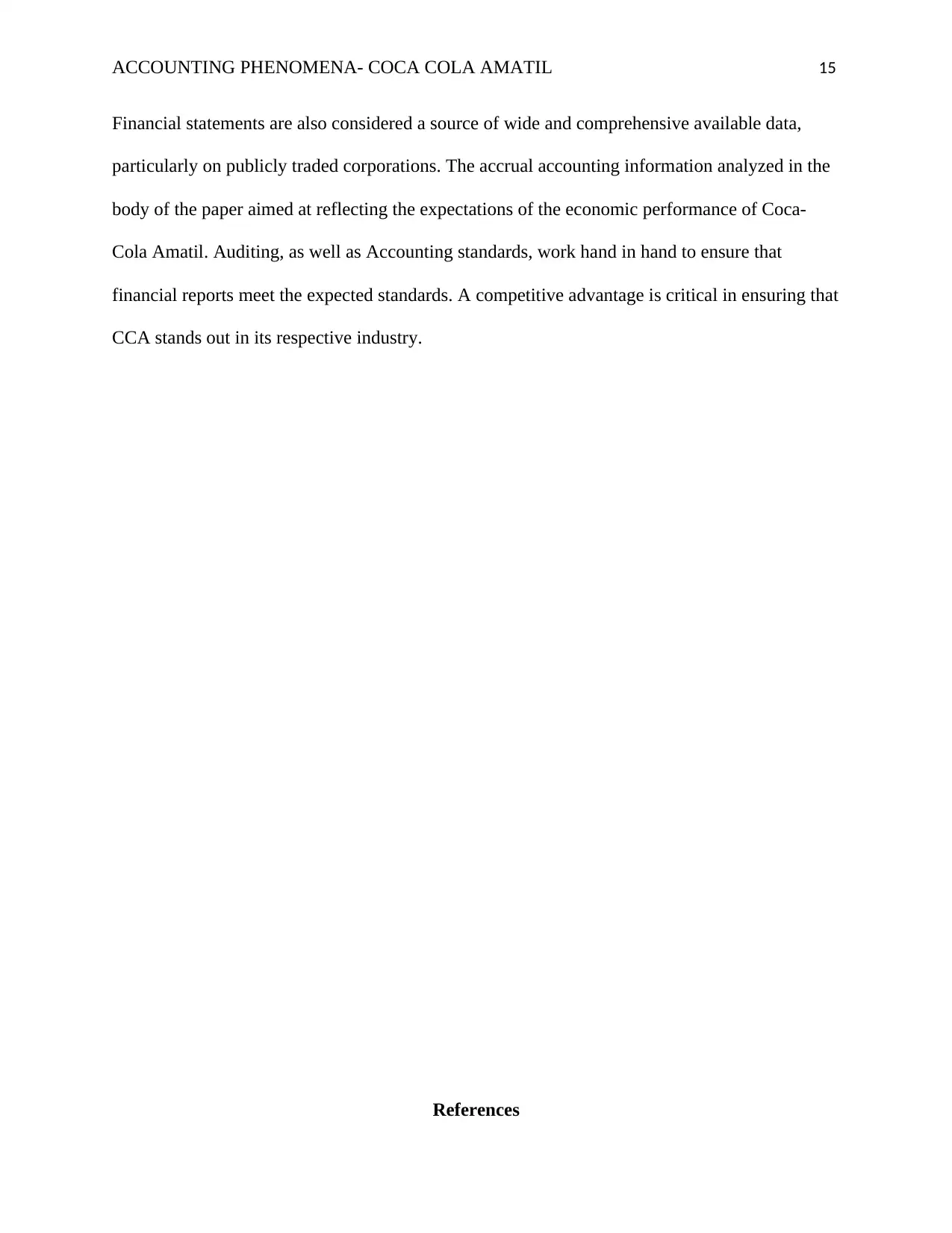
ACCOUNTING PHENOMENA- COCA COLA AMATIL 15
Financial statements are also considered a source of wide and comprehensive available data,
particularly on publicly traded corporations. The accrual accounting information analyzed in the
body of the paper aimed at reflecting the expectations of the economic performance of Coca-
Cola Amatil. Auditing, as well as Accounting standards, work hand in hand to ensure that
financial reports meet the expected standards. A competitive advantage is critical in ensuring that
CCA stands out in its respective industry.
References
Financial statements are also considered a source of wide and comprehensive available data,
particularly on publicly traded corporations. The accrual accounting information analyzed in the
body of the paper aimed at reflecting the expectations of the economic performance of Coca-
Cola Amatil. Auditing, as well as Accounting standards, work hand in hand to ensure that
financial reports meet the expected standards. A competitive advantage is critical in ensuring that
CCA stands out in its respective industry.
References
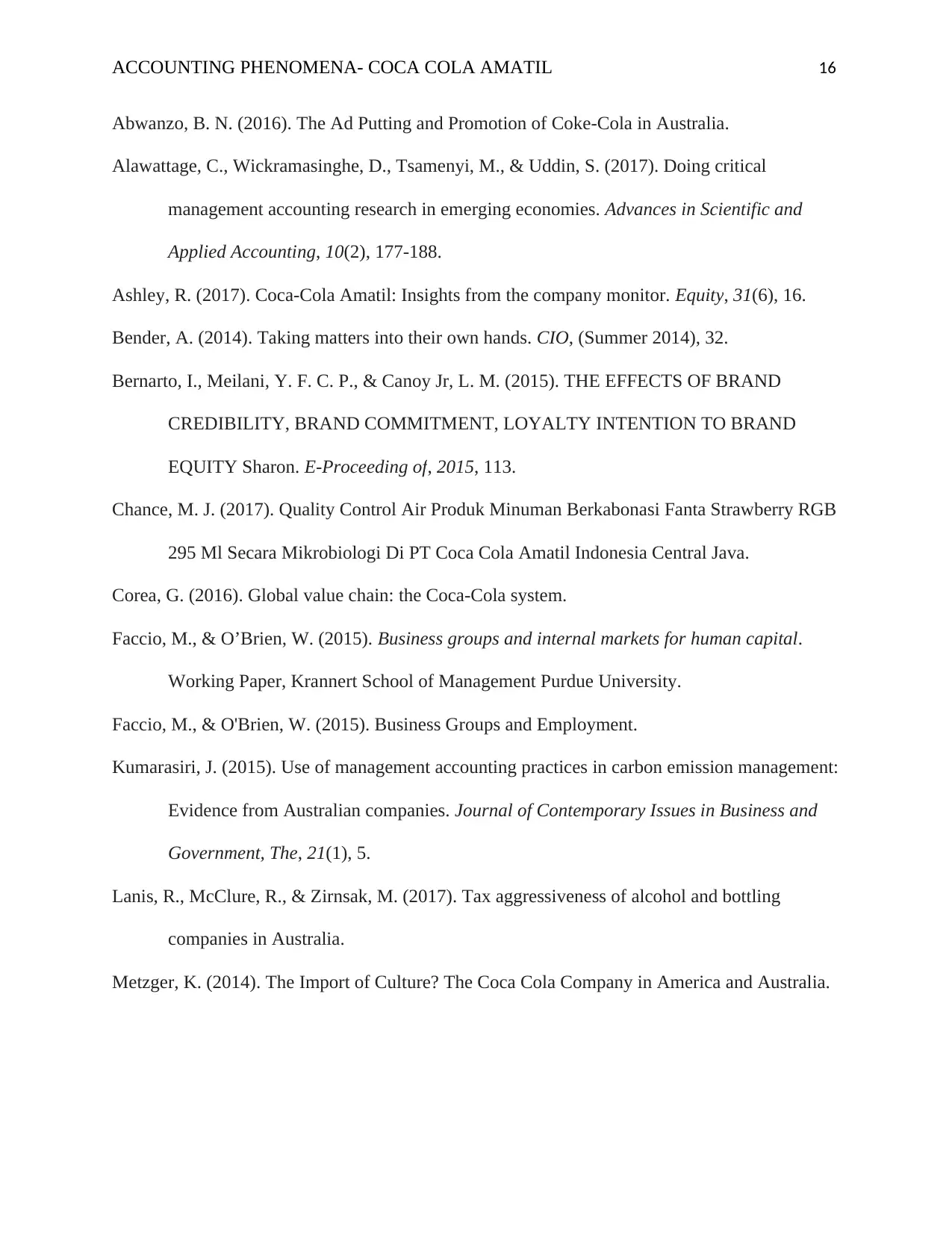
ACCOUNTING PHENOMENA- COCA COLA AMATIL 16
Abwanzo, B. N. (2016). The Ad Putting and Promotion of Coke-Cola in Australia.
Alawattage, C., Wickramasinghe, D., Tsamenyi, M., & Uddin, S. (2017). Doing critical
management accounting research in emerging economies. Advances in Scientific and
Applied Accounting, 10(2), 177-188.
Ashley, R. (2017). Coca-Cola Amatil: Insights from the company monitor. Equity, 31(6), 16.
Bender, A. (2014). Taking matters into their own hands. CIO, (Summer 2014), 32.
Bernarto, I., Meilani, Y. F. C. P., & Canoy Jr, L. M. (2015). THE EFFECTS OF BRAND
CREDIBILITY, BRAND COMMITMENT, LOYALTY INTENTION TO BRAND
EQUITY Sharon. E-Proceeding of, 2015, 113.
Chance, M. J. (2017). Quality Control Air Produk Minuman Berkabonasi Fanta Strawberry RGB
295 Ml Secara Mikrobiologi Di PT Coca Cola Amatil Indonesia Central Java.
Corea, G. (2016). Global value chain: the Coca-Cola system.
Faccio, M., & O’Brien, W. (2015). Business groups and internal markets for human capital.
Working Paper, Krannert School of Management Purdue University.
Faccio, M., & O'Brien, W. (2015). Business Groups and Employment.
Kumarasiri, J. (2015). Use of management accounting practices in carbon emission management:
Evidence from Australian companies. Journal of Contemporary Issues in Business and
Government, The, 21(1), 5.
Lanis, R., McClure, R., & Zirnsak, M. (2017). Tax aggressiveness of alcohol and bottling
companies in Australia.
Metzger, K. (2014). The Import of Culture? The Coca Cola Company in America and Australia.
Abwanzo, B. N. (2016). The Ad Putting and Promotion of Coke-Cola in Australia.
Alawattage, C., Wickramasinghe, D., Tsamenyi, M., & Uddin, S. (2017). Doing critical
management accounting research in emerging economies. Advances in Scientific and
Applied Accounting, 10(2), 177-188.
Ashley, R. (2017). Coca-Cola Amatil: Insights from the company monitor. Equity, 31(6), 16.
Bender, A. (2014). Taking matters into their own hands. CIO, (Summer 2014), 32.
Bernarto, I., Meilani, Y. F. C. P., & Canoy Jr, L. M. (2015). THE EFFECTS OF BRAND
CREDIBILITY, BRAND COMMITMENT, LOYALTY INTENTION TO BRAND
EQUITY Sharon. E-Proceeding of, 2015, 113.
Chance, M. J. (2017). Quality Control Air Produk Minuman Berkabonasi Fanta Strawberry RGB
295 Ml Secara Mikrobiologi Di PT Coca Cola Amatil Indonesia Central Java.
Corea, G. (2016). Global value chain: the Coca-Cola system.
Faccio, M., & O’Brien, W. (2015). Business groups and internal markets for human capital.
Working Paper, Krannert School of Management Purdue University.
Faccio, M., & O'Brien, W. (2015). Business Groups and Employment.
Kumarasiri, J. (2015). Use of management accounting practices in carbon emission management:
Evidence from Australian companies. Journal of Contemporary Issues in Business and
Government, The, 21(1), 5.
Lanis, R., McClure, R., & Zirnsak, M. (2017). Tax aggressiveness of alcohol and bottling
companies in Australia.
Metzger, K. (2014). The Import of Culture? The Coca Cola Company in America and Australia.
Secure Best Marks with AI Grader
Need help grading? Try our AI Grader for instant feedback on your assignments.
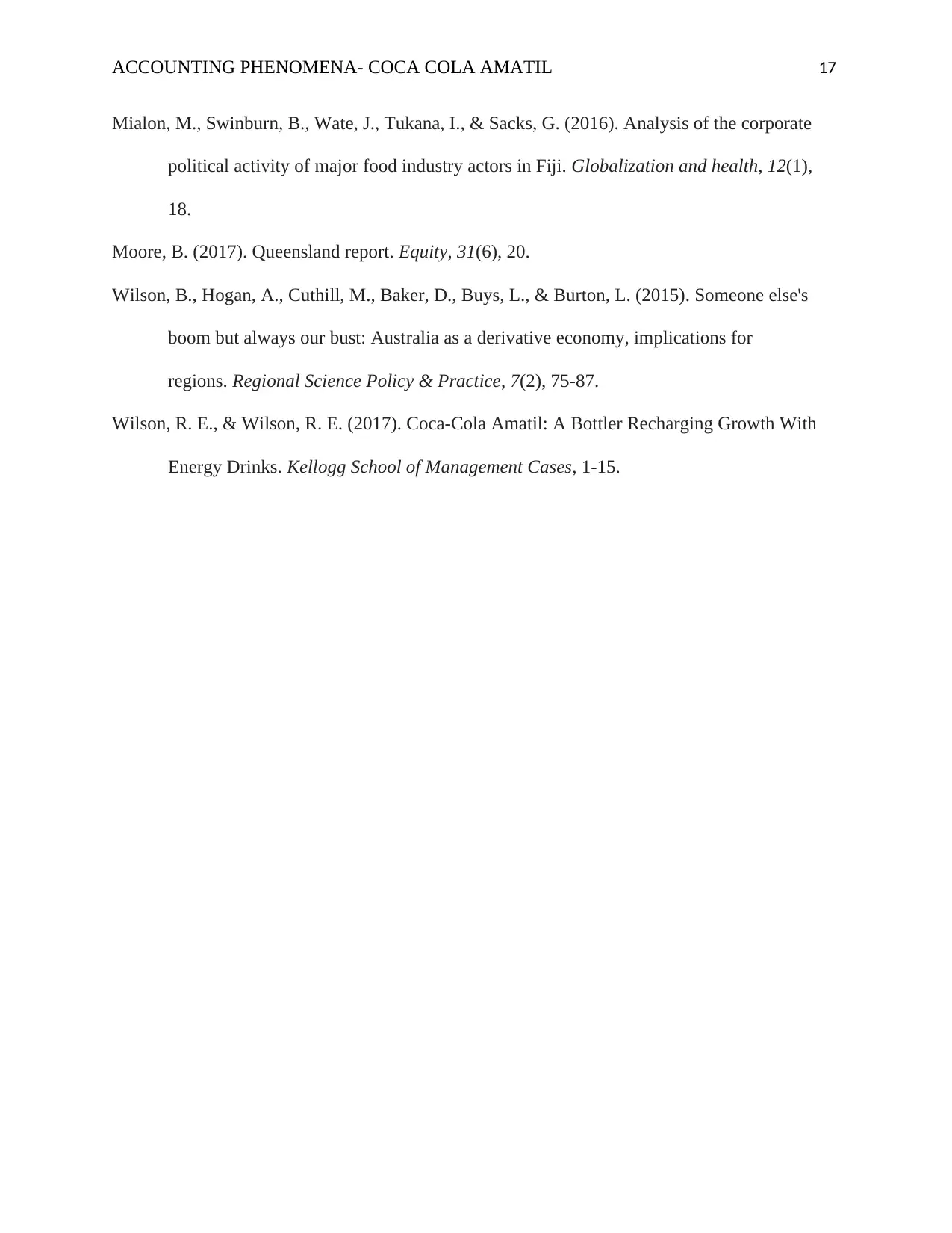
ACCOUNTING PHENOMENA- COCA COLA AMATIL 17
Mialon, M., Swinburn, B., Wate, J., Tukana, I., & Sacks, G. (2016). Analysis of the corporate
political activity of major food industry actors in Fiji. Globalization and health, 12(1),
18.
Moore, B. (2017). Queensland report. Equity, 31(6), 20.
Wilson, B., Hogan, A., Cuthill, M., Baker, D., Buys, L., & Burton, L. (2015). Someone else's
boom but always our bust: Australia as a derivative economy, implications for
regions. Regional Science Policy & Practice, 7(2), 75-87.
Wilson, R. E., & Wilson, R. E. (2017). Coca-Cola Amatil: A Bottler Recharging Growth With
Energy Drinks. Kellogg School of Management Cases, 1-15.
Mialon, M., Swinburn, B., Wate, J., Tukana, I., & Sacks, G. (2016). Analysis of the corporate
political activity of major food industry actors in Fiji. Globalization and health, 12(1),
18.
Moore, B. (2017). Queensland report. Equity, 31(6), 20.
Wilson, B., Hogan, A., Cuthill, M., Baker, D., Buys, L., & Burton, L. (2015). Someone else's
boom but always our bust: Australia as a derivative economy, implications for
regions. Regional Science Policy & Practice, 7(2), 75-87.
Wilson, R. E., & Wilson, R. E. (2017). Coca-Cola Amatil: A Bottler Recharging Growth With
Energy Drinks. Kellogg School of Management Cases, 1-15.
1 out of 17
Related Documents
Your All-in-One AI-Powered Toolkit for Academic Success.
+13062052269
info@desklib.com
Available 24*7 on WhatsApp / Email
![[object Object]](/_next/static/media/star-bottom.7253800d.svg)
Unlock your academic potential
© 2024 | Zucol Services PVT LTD | All rights reserved.





